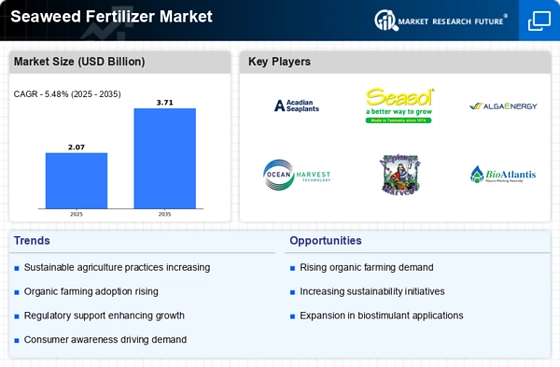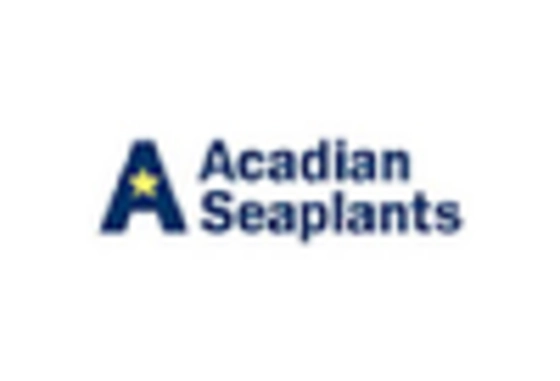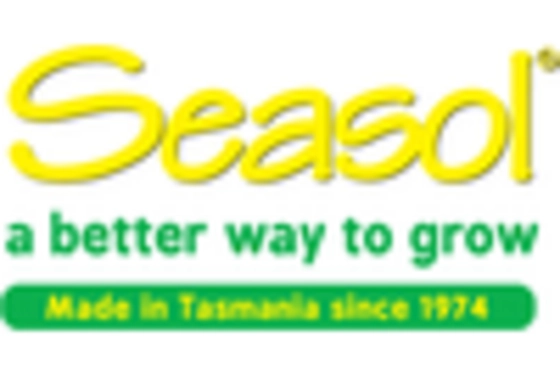Nutrient-Rich Composition
The nutrient-rich composition of seaweed fertilizers is another compelling driver for the Seaweed Fertilizer Market. Seaweed is known to contain a plethora of essential nutrients, including nitrogen, phosphorus, potassium, and trace minerals, which are vital for plant growth. This unique composition not only enhances soil health but also improves crop yield and quality. Data suggests that the use of seaweed fertilizers can increase crop productivity by up to 20%, making them an attractive option for farmers seeking to maximize their output. As agricultural practices increasingly focus on enhancing soil fertility and crop performance, the demand for nutrient-dense seaweed fertilizers is likely to rise. This trend indicates that the Seaweed Fertilizer Market is well-positioned to capitalize on the growing need for effective and sustainable agricultural inputs.
Sustainability Initiatives
The increasing emphasis on sustainability appears to be a pivotal driver for the Seaweed Fertilizer Market. As agricultural practices evolve, there is a growing recognition of the environmental benefits associated with seaweed fertilizers. These products are derived from renewable resources, which aligns with the global shift towards sustainable farming. Reports indicate that the market for organic fertilizers, including seaweed-based options, is projected to reach USD 10 billion by 2027. This trend suggests that consumers and farmers alike are prioritizing eco-friendly solutions, thereby enhancing the demand for seaweed fertilizers. Furthermore, regulatory frameworks are increasingly favoring sustainable practices, which could further bolster the market. The Seaweed Fertilizer Market is thus positioned to benefit from these sustainability initiatives, as they resonate with both consumer preferences and regulatory requirements.
Government Support and Policies
Government support and favorable policies are emerging as crucial drivers for the Seaweed Fertilizer Market. Many governments are actively promoting sustainable agricultural practices through subsidies and incentives for organic farming. This support is particularly evident in regions where agriculture plays a vital role in the economy. For instance, initiatives aimed at reducing chemical fertilizer usage have led to increased funding for research and development of organic alternatives, including seaweed fertilizers. Such policies not only encourage farmers to adopt eco-friendly practices but also enhance the visibility and acceptance of seaweed fertilizers in the market. The Seaweed Fertilizer Market stands to benefit from these governmental initiatives, as they create a conducive environment for the growth and adoption of sustainable agricultural inputs.
Rising Awareness of Organic Farming
The rising awareness of organic farming practices is significantly influencing the Seaweed Fertilizer Market. As consumers become more health-conscious and environmentally aware, the demand for organic produce continues to surge. This shift is reflected in the increasing number of organic farms, which have reportedly grown by over 30% in recent years. Seaweed fertilizers, being organic in nature, are gaining traction among farmers who wish to comply with organic certification standards. The market for organic fertilizers, including seaweed-based options, is expected to expand, with projections indicating a compound annual growth rate of 12% through 2027. This growing awareness and adoption of organic farming practices suggest that the Seaweed Fertilizer Market will experience robust growth as it aligns with consumer preferences for organic and sustainable agricultural solutions.
Technological Innovations in Production
Technological innovations in the production of seaweed fertilizers are likely to serve as a significant driver for the Seaweed Fertilizer Market. Advances in extraction and processing techniques have improved the efficiency and effectiveness of seaweed fertilizers, making them more appealing to farmers. Innovations such as enzymatic extraction and fermentation processes have enhanced the bioavailability of nutrients in seaweed, thereby increasing their efficacy as fertilizers. Furthermore, the integration of technology in the supply chain, including precision agriculture and data analytics, is enabling farmers to optimize the use of seaweed fertilizers for better crop management. As these technologies continue to evolve, they may further stimulate the growth of the Seaweed Fertilizer Market by providing farmers with more effective and efficient solutions for enhancing soil health and crop productivity.

















Leave a Comment